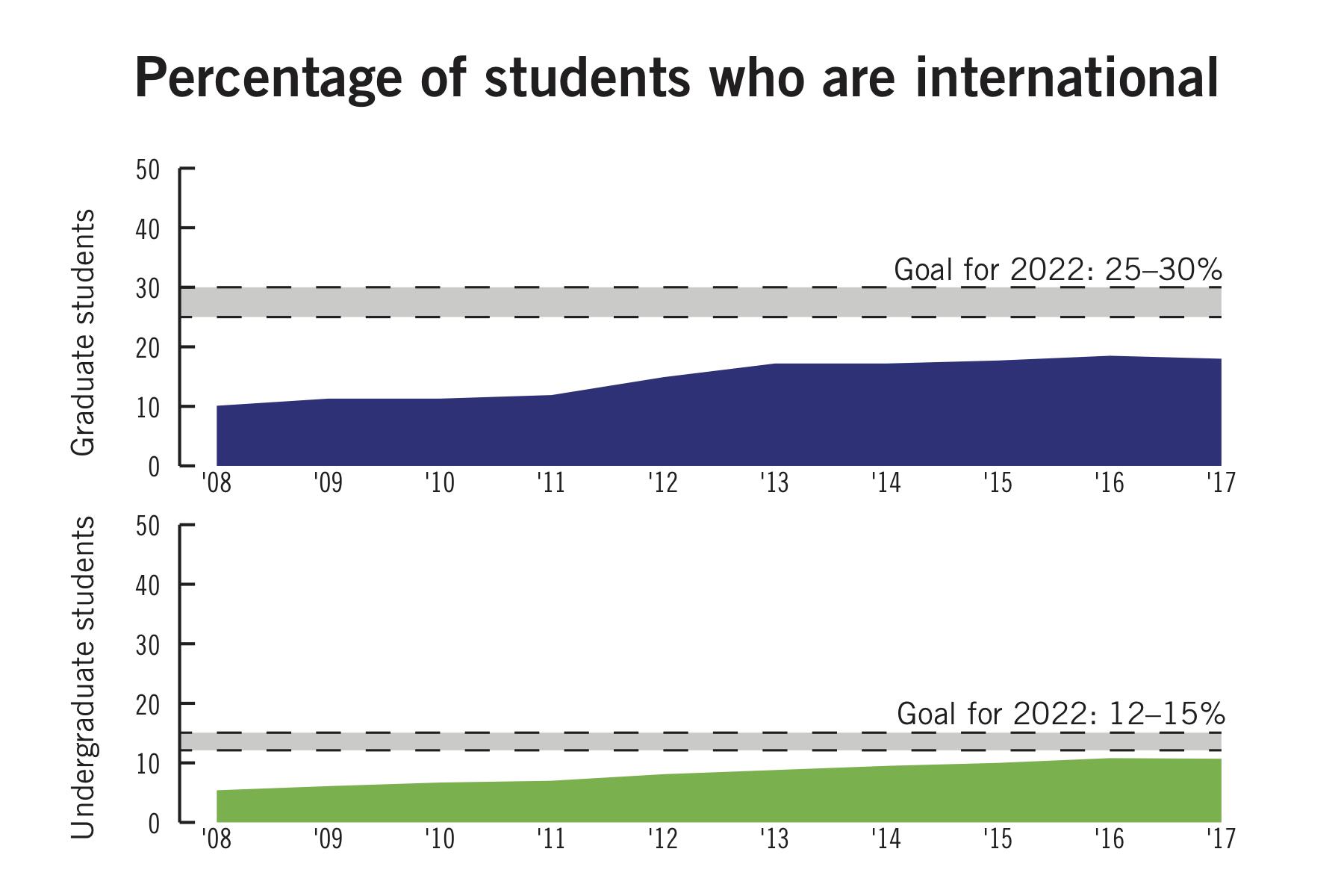
Yonah Bromberg Gaber | Graphics Editor
Updated: Dec. 15, 2017 at 3:40 p.m.
International students make up a smaller proportion of the total student body this fall – the first decline in at least nine years.
While the total number of international students enrolled increased slightly between fall 2016 and 2017, the percentage of the group as a share of the University’s total enrollment dipped from 15.5 to 15.2 percent, according to institutional data. Officials said the drop follows a national slowdown in international student enrollment across the nation in the wake of President Donald Trump’s election last November.
The stagnant growth of international enrollment is a setback as the University tries to grow its international student population, admitting students who bring diverse viewpoints and new research perspectives to campus and who often pay full tuition. In 2013, the University set a goal to increase the percentage of international students to a total of 12 to 15 percent of the undergraduate student population and 25 to 30 percent of the graduate population by 2022.
For undergraduate students, the percentage of international students dropped slightly from 10.8 percent to 10.7 percent, and for graduate students, the percentage dropped from 18.5 percent to 18 percent.
Laurie Koehler, the vice provost for enrollment management and retention, said the University has made “significant progress” in its international student enrollment in the past and will continue to make international recruitment a priority in the future. She declined to say if the drop this year was concerning.
The University enrolled nearly 28,000 students in fall 2017, an increase of about 800 and the most in GW’s history, but brought only 30 more international students to campus than in 2016.
Koehler pointed to a 2017 Open Doors survey, which found that the growth of international student enrollment has slowed at universities nationwide beginning in fall of 2016. American colleges and universities reported that international student enrollment had swelled 3 percent in the 2016-17 academic year, but the rate of growth was slower than in years past, according to the survey.
Koehler said “uncertainty surrounding the policies of the new administration” could be a factor in the decline.
“We will continue to work with our current and prospective students so that they know that they are welcome here at GW,” she said in an email.
While GW has turned to countries like China and South Korea to recruit much of its international student population in recent years, officials said earlier this semester that they were looking to expand the diversity of GW’s international student population and recruit from more places across the world.
Experts said a decrease in the percentage of international students could be due to the political climate in the U.S. when applications were due. After Trump was elected in November on a platform of strict immigration regulations and a U.S.-Mexico border wall, experts said international enrollment could plummet as foreign students worried about their safety and new obstacles to complete their education.
Greg Rainey, the CEO of McGovern Education Group, which recruits international students for American colleges and universities, said the Trump administration’s travel ban and stories of students and professors being banned from entering the U.S. from six Muslim-majority countries also impacted students who are not from those countries.
Last spring, an Iranian financial worker set to start graduate school at GW had his visa revoked when Trump’s travel ban took effect.
Rainey said many families of international students feared for the safety of their children going to the U.S., and that prospective students may have been hesitant to submit applications.
Rainey said GW, like other top 100 universities, would be impacted first because these schools are the most popular destinations for international students, especially students from China and India. Roughly 60 percent of GW’s international students come from China and India, according to institutional research.
“Although the travel ban did not actually ban them from traveling to the U.S., the whole idea of America specifically sending the messages to the world that we don’t want people visiting us from those countries is unheard of,” he said.
Michael Beseda, the vice provost for strategic enrollment management at the University of San Francisco, said the Trump administration was likely a large factor in slowing international enrollment trends because international enrollment continues to increase in countries like Canada, Australia and the United Kingdom.
“The luster of the U.S. education was slightly less lustrous in this last cycle,” he said.
Beseda added that the small drop GW experienced this year is not likely to have a huge impact.
“Certainly it’s a real number of students, but it’s hardly a 10 percent decline,” he said.
This post was updated to reflect the following correction:
On one reference, The Hatchet incorrectly spelled Greg Rainey’s last name. It is now spelled correctly. We regret this error.




